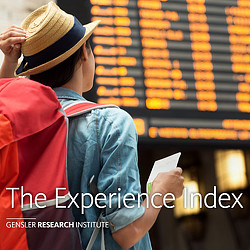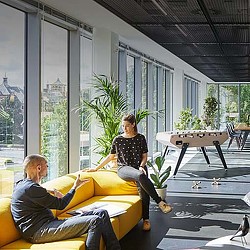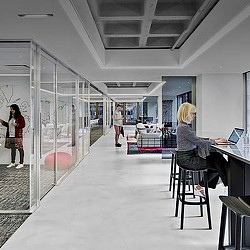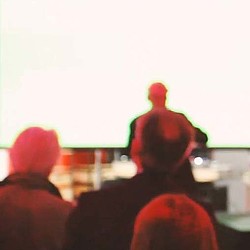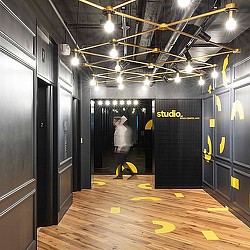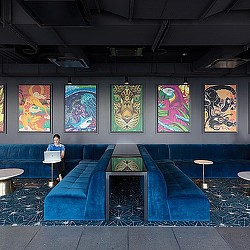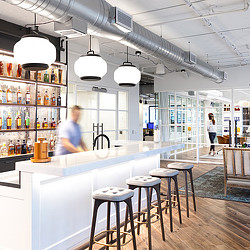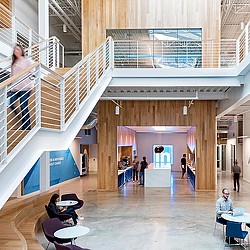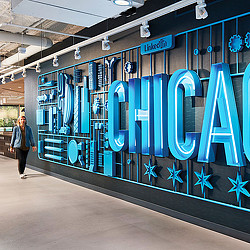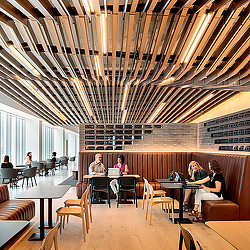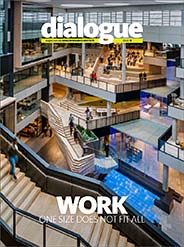In this age of economic uncertainty and rapid change, what actions are global companies taking to prepare for success? We talk with industry leaders about how to create a global workplace platform that works today and adapts to an uncertain future.


How does design play a role in Hyatt Hotels’ strategic direction?
Kristen Conry: Corporations in general are becoming more attuned to the role design plays in their success. Whether or not their core business is rooted in physical space, as Hyatt’s is, they’re starting to appreciate the value design can contribute. It’s now common for corporations to think about the design process as a strategic step. They’re thinking more critically about the issues they’re trying to address and gathering information and data to understand these issues in a more objective and analytical sense.
Every real estate project is an opportunity to better address a need, and so we try to gather information and data that will help us understand the overall context surrounding every project. It’s very important to be targeted in what you do and to focus on who you’re designing for and what you’re trying to solve. You have to ask the right questions before even putting pencil to paper in terms of a design.
Strategy has always been fundamental to what architects and designers do. Today, we can take it even further. We are in an era in which we have the capability to collect and analyze information that gives us unprecedented insight into the mindsets of the people who ultimately inhabit spaces. There’s more and more interest in and information available on the psychology of space and the way people respond to design. We can use this information to better understand the impact design decisions have on end users, and then use design to enable the best possible experiences for them.
Design strategy is becoming even more objective, more scientific. As this happens, expectations of work environments are rising. People expect and demand more of design, and this is a great evolution — a more informed, engaged, enthusiastic, and critical public will raise the bar in terms of possibilities. At Hyatt, our purpose is to care for people so they can be their best. Whether those people are our guests, colleagues, or partners, design plays a critical role in delivering on this promise.
In what ways are the expectations of new workers impacting your workplace?
KC: I think their way of working is a bit more casual. It’s more flexible. They’re looking for high functionality. It’s less about status and exclusivity and the corner office, and more about, “How does this place work? How can I identify with it? How is it meeting my needs?” They’re not as focused on climbing the corporate ladder, so to speak. They care more about every experience and tend to focus their time and efforts on having meaningful experiences that bolster their sense of identity.
This sort of mindset has big implications for how we think of the workplace. Because if new workers aren’t motivated by traditional hierarchies of status, you have to rethink how your workplace conveys recognition. What is the currency of value that matters to this younger generation? They want the everyday to be motivating and meaningful. That means highly functional, technology-enabled settings and platforms that support what someone needs to do. It means better connections with colleagues and more lifestyle opportunities. It’s a bigger emphasis on wellness and well-being. It’s all of these things and more, and it has to resonate with the core identity people bring with them to the workplace.
Are you looking at ways that physical space can promote a culture of innovation?
KC: When you’re talking about innovation, it’s important to question assumptions around what innovation really is and what it looks like. There was a period of time in the recent past when everyone associated innovation with more openness, more collaboration, and more opportunity for ideas to come together in a serendipitous way. So big collaborative spaces got branded with the “innovative” label.
More recently, we’ve learned that it’s not so simple. Innovation is not an ongoing giant brainstorming session that happens because you have very communal and social spaces. True innovation occurs when you recognize every workforce is composed of extroverts and introverts, and you therefore have to find a balance between collaboration and focus, as well as socialization. I find that the physical spaces that promote innovation do so by getting people in the right mindset. Innovation is not spontaneity. It’s a very disciplined and rigorous process. You have to help people find and renew their energy and create physical spaces for that to happen. Because those are the things that are fundamental to cultivating a very engaged, motivated workforce that can productively contribute to an innovative culture.


How do you create a global workplace platform capable of adapting to future changes that may be hard to foresee?
Frank Cuevas: Technology is innovating at an exponential pace, and that means we have to innovate faster in everything we do. In terms of space, we emphasize the importance of designing for flexibility. A year ago, we created a set of guidelines for our workplaces focused on making sure we’re as agile and nimble as possible. That means more movable desks and a renewed focus on shared spaces with furniture that can be reconfigured very easily depending on people’s needs. It also meant supporting our open plan office spaces with closed spaces. Research shows that there are three or four different ways in which people work on any given day, so we try to provide a mix of spaces — like client spaces, spaces for heads-down time, collaborative settings, and social settings.
Are you looking at ways that design can promote a culture of innovation?
FC: When I think about innovation at work, I think of environments that are similar in look and feel to coworking spaces or incubator spaces. I think of the garage-type settings like the ones tech startups tend to inhabit. We have spaces in our offices around the world that we’re calling “garages.” These spaces are a bit quirkier in terms of style and design. They have more colorful components and different sorts of furniture. For example, instead of a traditional conference table, you might have a big slab on a bunch of wooden crates. It’s a different type of design, but these are the kinds of spaces you find at incubators or startups. What’s interesting is that a lot of startups aren’t spending much money on their spaces, but they’re creating environments where people can come together and innovate.
As startups have shown, you don’t have to spend a lot of money to create settings that encourage people to think in new ways.
FC: That’s right. If you create a corporate, sterile setting where you’re spending a thousand dollars on a desk, it might even inhibit what you’re trying to accomplish in terms of creating an innovative environment. You don’t have to spend a lot of money, but you have to be creative in terms of how you design. That’s the key to getting people to think differently and incorporate that sort of thinking into their work.
Is IBM trying to find a balance between urban and suburban locations in your real estate portfolio?
FC: We look for a balance, though it’s clear that a lot of people prefer an urban setting to a suburban one. The urban lifestyle appeals to younger people and even older empty nesters, many of whom are moving back to metro areas where cultural institutions and other amenities are just a walk away. That being said, the suburbs are not going away. Suburbs are a very big component of our real estate portfolio strategy. We prefer suburbs that are within a commutable distance to metro centers so that people can get back and forth easily. What I think will happen in the future is that more suburbs will start to “urbanize” to redefine what it means for them to be competitive. Suburbs will adopt a “live/work/play/learn” attitude similar to what cities already have. So those who remain in the suburbs can enjoy the advantages of an urban lifestyle.
How do you address cultural differences across so many countries?
FC: Every country is extremely proud of their own culture, so we have to make sure that we respectfully acknowledge what that culture is and incorporate it into our design. The way people work in Japan is different from the way people work in Western Europe or even Eastern Europe. As an example, people in Japan are so collaborative in many ways, but they don’t work in big, open settings. Different cultures have their own ideas of what collaboration looks like, and the workplace has to take those distinctions into consideration.
In our design work, we always try to incorporate local flavor, so the space resonates with the people who use it. We don’t want people coming to work thinking they’re working for this big American company. We are a multinational company, and our offices tend to reflect the culture of the surrounding area. We incorporate local culture through branding and wall graphics, as well as the overall design scheme and the materials used. All of that gets considered when we look at the design of a space.


What are you working on now to achieve an adaptable workplace for LinkedIn?
Brett Hautop: We’re looking at where the sensor technology explosion has been happening. We’re trying to determine: what data is valuable, how do we get it in a timely manner, and how can we use it in a thoughtful and insightful way? Our workplace innovation team was at Microsoft yesterday meeting with a data science team that is taking all the data sets, running algorithms, and looking at the probability that certain things will happen. We’re looking at patterns over time and trying to understand how to adapt space to accommodate how people are actually working. We’re trying to understand micro-change that happens within teams by the day, the week, and the month.
We hope that we can create a working ecosystem that allows people to get what they need out of the space when they need it: a flexible kit-of-parts that doesn’t require submitting a ticket or a drawn-out process. All the apps we have in life are hyper-responsive to our needs and anticipate what we’re going to want. We’re trying to figure out how the workplace can similarly anticipate what teams want and need. It’s a lot easier said than done, but that’s where we’re headed. We have a workplace laboratory where we test a lot of these concepts on ourselves. We’re also going to test to see if there’s a difference between generations’ willingness to accept an environment that reacts to its occupants.
How do you factor recruitment and retention into the workplace?
BH: When all the other companies we’re competing against have similar services and amenities, it gets down to other factors. What does the environment feel like? A fun, engaging, and dynamic workplace is what really appeals, but it’s not very effective for our talent acquisition team to send out a marketing packet showing how wonderful it is. The generation we’re looking to hire believes what they see on social media. If it’s been corroborated on social media and people are posting positive content about our spaces, that’s huge for us. So, we’re actually evaluating completed projects from a recruiting perspective related to social media traffic: who is looking at our posts, who is finding information about our spaces, and how are they engaging with it?
We’re trying to create a collective workplace experience across all the points along the way: from the moment you hear about LinkedIn or see one of our spaces online, all the way through your career. There are thousands of touchpoints along the employee journey. We’re starting the process of cataloguing them, and we’re trying to learn which ones are most impactful.
Across your global locations, do cultural differences influence the workplace experience and how you design for it?
BH: We try to deliver spaces that are very connected to the local culture and are tied to the people who work there. That’s manifested in our environmental graphic design program as well as furniture selection. We work with local vendors and fabricators to do things that people can point to with pride and say, “That’s from my town, and there’s a story to tell.”
We don’t have global standards. We have guidelines, but we want every office to feel completely unique. That takes a lot of extra work, because it means we don’t have a cut-and-paste process. There are specific cultural differences like the size of a desk, or the space between desks. In some places, people want to sit closer together, even if it feels tight. In other places, the code requires that you can’t be more than a certain distance from natural light.
We need to solve for the same basic problems as everyone with global offices. But instead of either delivering a global standard that is the same in every country or designing offices that are not tied to our global brand and only address the local culture, we are trying to do both. That’s more challenging. In extreme cases like Dublin, a LinkedIn office where well over 50 languages are spoken, it’s like a global village. It becomes about celebrating many different cultures while still being true to the local place.
Kevin Craft is a writer/editor at Gensler, located in Washington, DC.
Adam Zurbruegg is Gensler’s firmwide marketing leader, based in New York.
